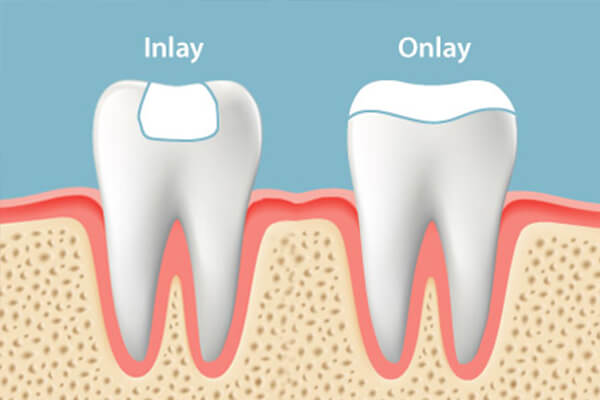Dental Inlays & Onlays: Differences, Pros and Cons, and More

Dental inlays and onlays are miniature prostheses: not yet a crown, but no longer a filling. They are cast structures that allow saving or changing the shape of the tooth, filling the carious cavity and restoring the chewing function.
Table of Contents:
- What Are Inlays and Onlays?
- What are Inlays and Onlays Made of?
- Ceramic Inlays: Pros and Cons
- Inlays vs Onlays vs Fillings vs Crowns
- What to Expect During the Procedure
- How Long Do Inlays and Onlays Last?
- Aftercare Tips for Inlays and Onlays
- How Much Does an Inlay or Onlay Cost?
- Summary
What Are Inlays and Onlays?
Dental inlays and onlays are elements of a certain shape, consisting of composite materials (porcelain or precious metals). They are used as an alternative to classic fillings, as they have a number of advantages, both in terms of functionality and aesthetics. Inlays and onlays, unlike some fillings, do not change size over time, which helps prevent discomfort and abrasion of the tooth by the filling.

Unlike filling material (rubber fillings), neither inlays nor onlays change color over time and perfectly retain the same appearance as a natural tooth. In addition, the advantage of inlays and onlays is their very precise fit to damaged or missing tooth tissues. Their use allows you to give the tooth not only its original appearance but, if necessary, to strengthen the weaker areas of the dental tissue with an additional coating that perfectly withstands the load.
What are Inlays and Onlays Made of?
Cermet
Inlays for tooth restoration are not made from this material. But this material is used for stump inlays – this is an intermediate stage in the complex restoration of the tooth. If the tooth is very badly damaged, channels are treated in it, orthopedists put a stump inlay inside. Such dental inserts are fixed in the roots of the tooth and serve as a support for the crowns.
Zirconium Dioxide
Restorative inlays and onlays are not made from this material. It is stump inlays that are made from zirconium dioxide, which strengthen the roots during complex tooth restoration. A crown is fixed on the stump inlay.
Pressed Ceramics
Modern clinics use e-max ceramics. The dental specialist will make the restoration based on your impressions. The ceramic inlay will be durable and aesthetic. It will not change in color and will not change in volume.
As one of the leading onlay and inlay suppliers in the U.S., sandelcenter.com recommends that you consider dental ceramic restorations. The pharmacy has an extensive experience and knowledge about the most advanced materials for direct restorations and is willing to share it with our readers. The company knows everything about ceramic dental materials, including their most relevant physical and mechanical properties. The pharmacy expert explained the benefits of ceramic inlays below.
Ceramic Inlays: Pros and Cons
Pros:
- require less tooth removal
- physical properties similar to those of dental enamel.
- better border sealing.
- simplified proximal contact geography.
- reduced stress at the edge of the filling as a result of masticatory pressure.
- lower thermal volume change in the filling.
- they are less likely to discolor over time.
Cons:
- high cost.
- the need to visit the clinic several times.
Inlays vs Onlays vs Fillings vs Crowns: What Are the Differences?
Dental Fillings vs Inlays
Theoretically, they can be used interchangeably, but inlays are usually used for much larger cavities. Both involve removing an existing cavity with a drill and filling in that empty space, but how that space is filled in the first place is different. A filling uses an amalgam or composite material to fill the space and is a much faster process requiring only one visit.
An inlay fills the space with a single piece of material, which is usually made in the laboratory, although sometimes they can be made in the office, and they are usually made of a material such as gold or ceramic.
The liner must be exactly the shape and size of the empty space, otherwise food and bacteria will get into the space, leading to further decomposition.
The advantage of inlays is that they do not shrink to the same extent as a filling once placed, so it is less likely to fail for this reason or create a gap between the filling and the surrounding tooth structure.
The inlays also create a stiffer and theoretically stronger surface for chewing use, and so the inlays should be more reliable in the long run, although the evidence for this is mixed and inconclusive.
Both fillings and inlays treat cavities but are not interchangeable. Dental inlays are more suitable for large cavities, especially on the back teeth, where chewing most often occurs. For an inlay, most of the tooth structure still needs to be intact. For cavities right on chewing surfaces, such as the center of a molar, inlays may be a better option than a traditional filling. They are often more durable and therefore better for chewing. Inlays are also less likely to fail over time than fillings.
Traditional fillings are usually recommended for minor caries. The process is fast and efficient and can be completed in one visit and save as many teeth as possible.
Onlays vs Dental Crowns
These are the largest single tooth restoration molds in terms of treatment area, designed for large areas of caries where a filling or inlay does not work due to the need to remove a large area of the tooth. The main difference between an onlay and an inlay is that an onlay covers the cusp of the tooth while an inlay only fills the area between the cusps. A cavity is also drilled in the tooth, and the lining is made exactly according to the size and shape of the space. A crown, on the contrary, will cover the entire bite surface of the tooth, as well as the area of the tooth above the gum line.
Compared to a crown, an onlay is a less aggressive restoration because less tooth structure needs to be removed to place an onlay. The cost is about the same, but the onlay is slightly cheaper than the crown. Thus, whenever possible, an onlay is the preferred restoration.
The picture below explains the basics of dental restorations:

Benefits of Inlays and Onlays Over Fillings
Dental inlays and onlays offer several advantages over traditional fillings and dental crowns:
- Durability: Over time, traditional dental fillings will weaken the remaining tooth structure. Conversely, dental inlays and onlays can actually help reinforce the remaining structure of the restored tooth. Inlays and onlays also last longer than regular dental fillings.
- Preservation of natural tissues: dental onlays can be used instead of dental crowns. Since far less tooth tissue is removed to place an onlay than a crown, it helps to keep the tooth as close to its original state as possible.
- Aesthetics: Dental inlays and onlays can be made from porcelain. A good dentist will be able to accurately match the color of your inlay or onlay to your natural teeth. Porcelain dental inlays and onlays will also be less prone to discoloration than synthetic resin dental restorations.
- Perfect fit: The fact that the inlays are made to exactly fit the broken area of the tooth helps to ensure a perfect fit. Compared to fillings, dental inlays are less likely to have small gaps between the tooth inlay and the remaining tooth tissue.
- An extremely strong and stable material that allows people to chew without fear of damaging their teeth.
What to Expect During the Procedure
The difference between an inlay and an onlay is that the inlay is placed inside the tooth while the onlay is placed on top, protecting the tooth from further decay. The manufacture and installation of inlays and onlays takes place in two stages. At the first stage, the doctor takes an impression, determining the part of the tooth, the absence of which must be compensated, and sends the results to the laboratory, where an inlay or onlay is made. Also, during the first visit, the doctor will install a temporary inlay or onlay that will protect the tooth while the permanent one is being made.
The doctor will offer all types of inlay or onlay material. It depends on the place of its use and on the requirements for it. For back teeth, the appearance is not very important – the main requirement is strength and chewing load. In this case, it is possible to use a metal inlay, which is much stronger and more durable. At the second stage, the temporary insert is removed and the permanent one is tried on, as well as it is fixed with dental cement.
The video below demonstrates an inlay procedure:
How Long Do Inlays and Onlays Last?
The average service life of a ceramic inlay is 10-20 years. This is 3-4 times longer than the average lifetime of a composite filling. Feedback from patients suggests that the ceramic inlay on the tooth lasts a long time and is not felt at all in the mouth. People just forget they have an inlay installed.
Aftercare Tips for Inlays and Onlays
Ceramic inlays do not require special care, it is enough to clean them in the same way as natural teeth. In order for the inlay or onlay to please you for many years, you need to follow some aftercare rules.
- Brush and paste your teeth twice a day;
- Use additional hygiene products (dental brushes, floss) to clean the interdental spaces;
- Use the irrigator at least once a day;
- Do not eat too hard, sticky food;
- Quit bad habits (biting threads, chewing on pens and pencils, etc.);
- Get a comprehensive professional cleaning of the oral cavity at least twice a year.
How Much Does an Inlay or Onlay Cost?
The cost of an inlay or onlay depends on the type of material used, the clinic and your state. Since inlays and onlays treat cavities and trauma-related dental conditions, part of the procedure may be covered by insurance.
These dental restorations are considered “major” dental procedures, meaning insurance can cover up to half of the cost. In this case, you will only pay a few hundred dollars out-of-pocket.
Below is the average cost of an inlay/onlay without insurance in the U.S.:
- Inlay — $650 – $1,200 (1 tooth)
- Onlay — $650 – $1,200 (1 tooth)
Summary
An inlay or onlay can help restore damaged teeth and prevent more serious dental problems. They’re not installed forever, but they can serve you for several years, depending on how well you care for your oral cavity. Do not forget to visit your dentist regularly to make them last longer.
Category: General
Tags: dental care, dental crowns, inlays, onlays, teeth health
